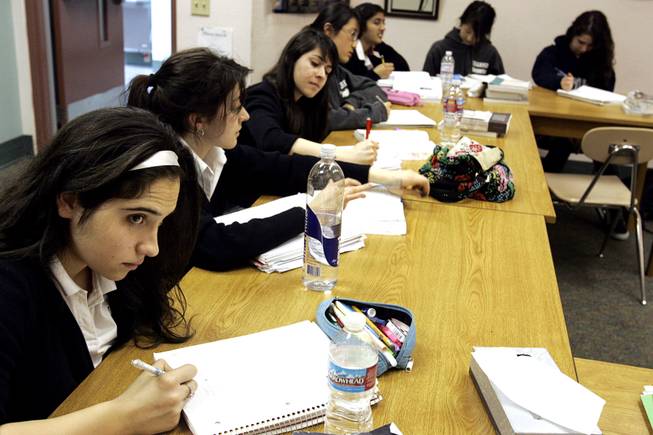
Senior Astrik Yepremyan, left, takes notes during AP European History class at the private Meadows School in Summerlin Thursday, March 4, 2010.
Wednesday, Jan. 25, 2017 | 2 a.m.
Families in the more affluent neighborhoods in Nevada are still the top applicants for the state’s education savings account program, new data show.
Updated information compiled by the Treasurer’s office this month indicates that not much has changed since 2015, though there seems to be a clear trend emerging when it comes to interest in the program: Parents living in middle- to upper-class neighborhoods remain much more likely to apply for the program than those living in low-income areas.
The new data include information on roughly 6,400 applicants entered into a state database. The total number is around 8,500, but some 2,000 applications have yet to be logged. When the Sun analyzed the application data in late 2015, the tally was around 3,000 overall.
Nevada's ESA program, the first of its kind nationwide to be passed without limiting applicants based on income, would deposit upwards of $5,100 in state education funds into a bank account to be used by approved families for things like private school tuition and tutoring. The program was put on hold last year after the state supreme court ruled that ESA funding couldn't come from the coffers of public education, but it could be revived by lawmakers this year.
ESA applications as of 2017
The new numbers show that the program continues to be most popular in Summerlin, Henderson and the golf-course studded suburbs south of Reno. Those places alone account for around 2,000 applications, nearly a third of all applicants for whom the state currently has demographic data.
In Henderson, applications nearly tripled over the course of last year. The two ZIP codes that account for the most applications are 89148 and 89178, extending from the southern part of Summerlin through Rhodes Ranch and ending in Mountain’s Edge. This area also includes Bishop Gorman, a prestigious Catholic private school.
Treasurer Dan Schwartz, a conservative and ardent supporter of the Republican-backed program, cautioned against reading too much into the data in terms of class.
“This is not an issue of rich or poor,” he said in a statement. “This is about empowering thousands of Nevada families who are trapped in mediocrity as Nevada struggles with a K-12 education system that is ranked 51st in the nation.”
The data seem to tell a different story. Families living in areas most affected by struggling schools don’t seem to be taking advantage of the program. The six ZIP codes containing the Clark County School District’s most struggling schools — indicated by a 1-star rating on the state’s Report Card — account for only 244 ESA applications, despite being home to around 250,000 people. By comparison, two ZIP codes, 89138 and 89144, consisting of around 8 square miles of homes in Summerlin, account for 271 applications and a population of around 30,000.
ESA applications as of October 2015
That's an application rate of one per 1,000 people in the inner city, contrasted with one per 100 people in the suburbs.
However, not all of the data cuts this way. Two standouts are 89110 and 89108, encompassing part of Hispanic/Latino-heavy eastern Las Vegas and a triangle of low-income neighborhoods west of the North Las Vegas Airport. They are the only neighborhoods with median household incomes well below the state average to file more than 100 applications, and they are areas with a high number of 2-star schools.
Possibly the most surprising trend, though, has nothing to do with income. It’s the extent to which families in areas with a high number of applications already have access to high-performing schools.
Take 89131. Residents in this northwest Las Vegas area near Floyd Lamb Park account for the most applications for a single ZIP code, yet they have direct access to eight 4- and 5-star schools. It’s the same situation in Summerlin. Residents living in upscale neighborhoods surrounding Charleston Boulevard and the 215 Beltway account for the third-highest number of applications, yet they have immediate access to six high-performing schools within 2 miles.
The meaning behind the numbers is much harder to parse. A lack of applications coming from the inner city doesn’t necessarily mean families there wouldn’t want to take advantage of the program. It could be true that there simply hasn’t been enough outreach by the state in low-income neighborhoods; The raw application data would seem to back that up.
But there are real barriers to low-income families who might want to participate. The fact that there are so few private schools in the inner city means families would likely have to arrange their own transportation. That’s a tall order in a city already plagued by transiency and a lack of parental engagement, to say nothing of the affordability of private school tuition even with an ESA.
In any case, the Legislature will meet next month, and Republicans are committed to approving $60 million budgeted by Gov. Brian Sandoval for the program over the next two years. Meanwhile, Democrats claim they have no desire to let the issue go to a vote.

Join the Discussion:
Check this out for a full explanation of our conversion to the LiveFyre commenting system and instructions on how to sign up for an account.
Full comments policy